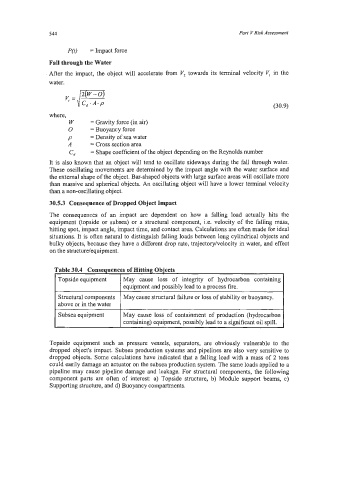Page 568 - Marine Structural Design
P. 568
544 Part V Risk Assessment
P(t) = Impact force
Fall through the Water
After the impact, the object will accelerate from V, towards its terminal velocity V, in the
water.
(30.9)
where,
W = Gravity force (in air)
0 = Buoyancy force
P = Density of sea water
A = Cross section area
Cd = Shape coefficient of the object depending on the Reynolds number
It is also known that an object will tend to oscillate sideways during the fall through water.
These oscillating movements are determined by the impact angle with the water surface and
the external shape of the object. Bar-shaped objects with large surface areas will oscillate more
than massive and spherical objects. An oscillating object will have a lower terminal velocity
than a non-oscillating object.
30.5.3 Consequence of Dropped Object Impact
The consequences of an impact are dependent on how a falling load actually hits the
equipment (topside or subsea) or a structural component, i.e. velocity of the falling mass,
hitting spot, impact angle, impact time, and contact area. Calculations are often made for ideal
situations. It is often natural to distinguish falling loads between long cylindrical objects and
bulky objects, because they have a different drop rate, trajectory/velocity in water, and effect
on the structuxdequipment.
Topside equipment May cause loss of integrity of hydrocarbon containing
equipment and possibly lead to a process fire.
Structural components May cause structural failure or loss of stability or buoyancy.
above or in the water
Subsea equipment May cause loss of containment of production (hydrocarbon
containing) equipment, possibly lead to a significant oil spill.
Topside equipment such as pressure vessels, separators, are obviously vulnerable to the
dropped object's impact. Subsea production systems and pipelines are also very sensitive to
dropped objects. Some calculations have indicated that a falling load with a mass of 2 tons
could easily damage an actuator on the subsea production system. The same loads applied to a
pipeline may cause pipeline damage and leakage. For structural components, the following
component parts are often of interest: a) Topside structure, b) Module support beams, c)
Supporting structure, and d) Buoyancy compartments.

